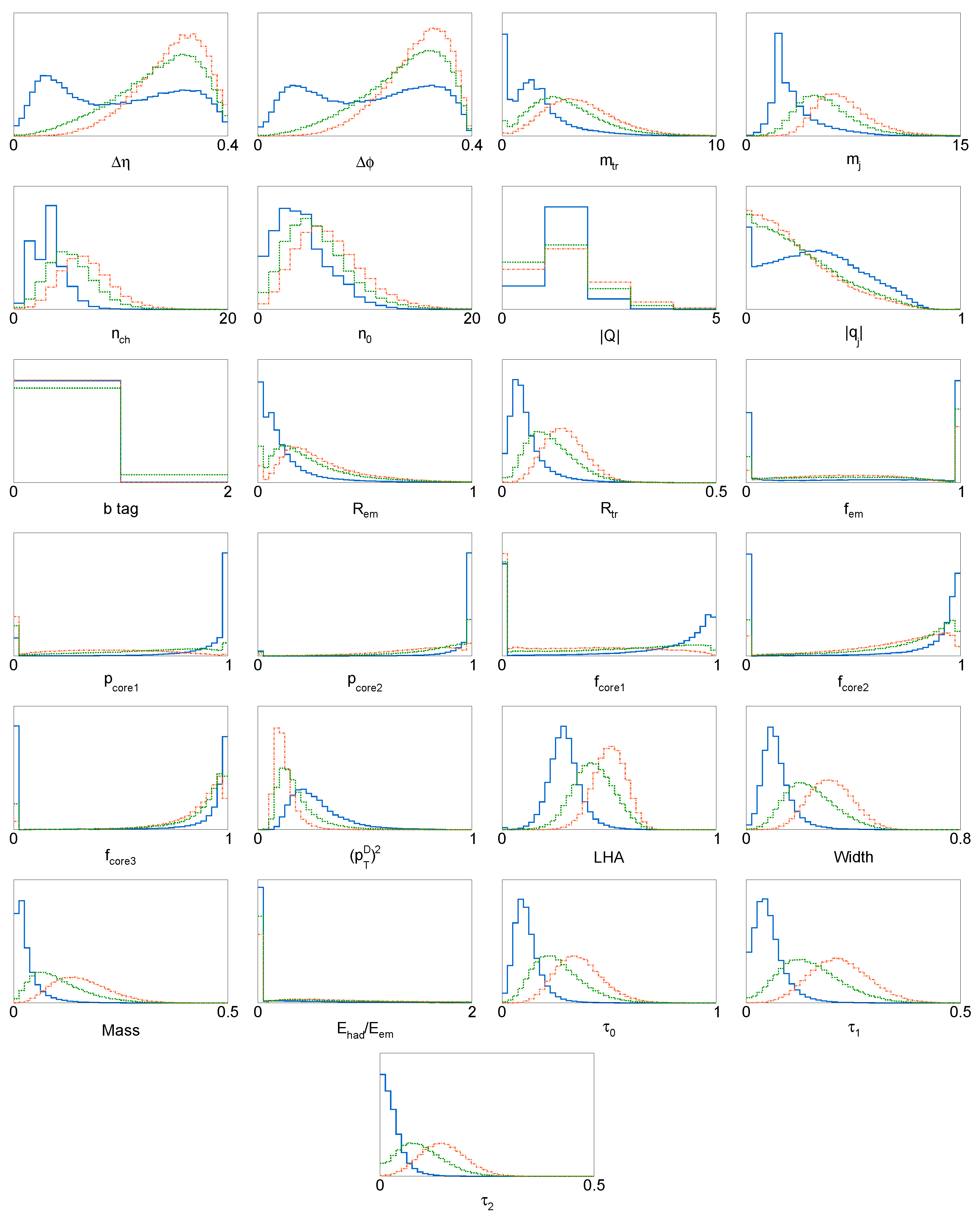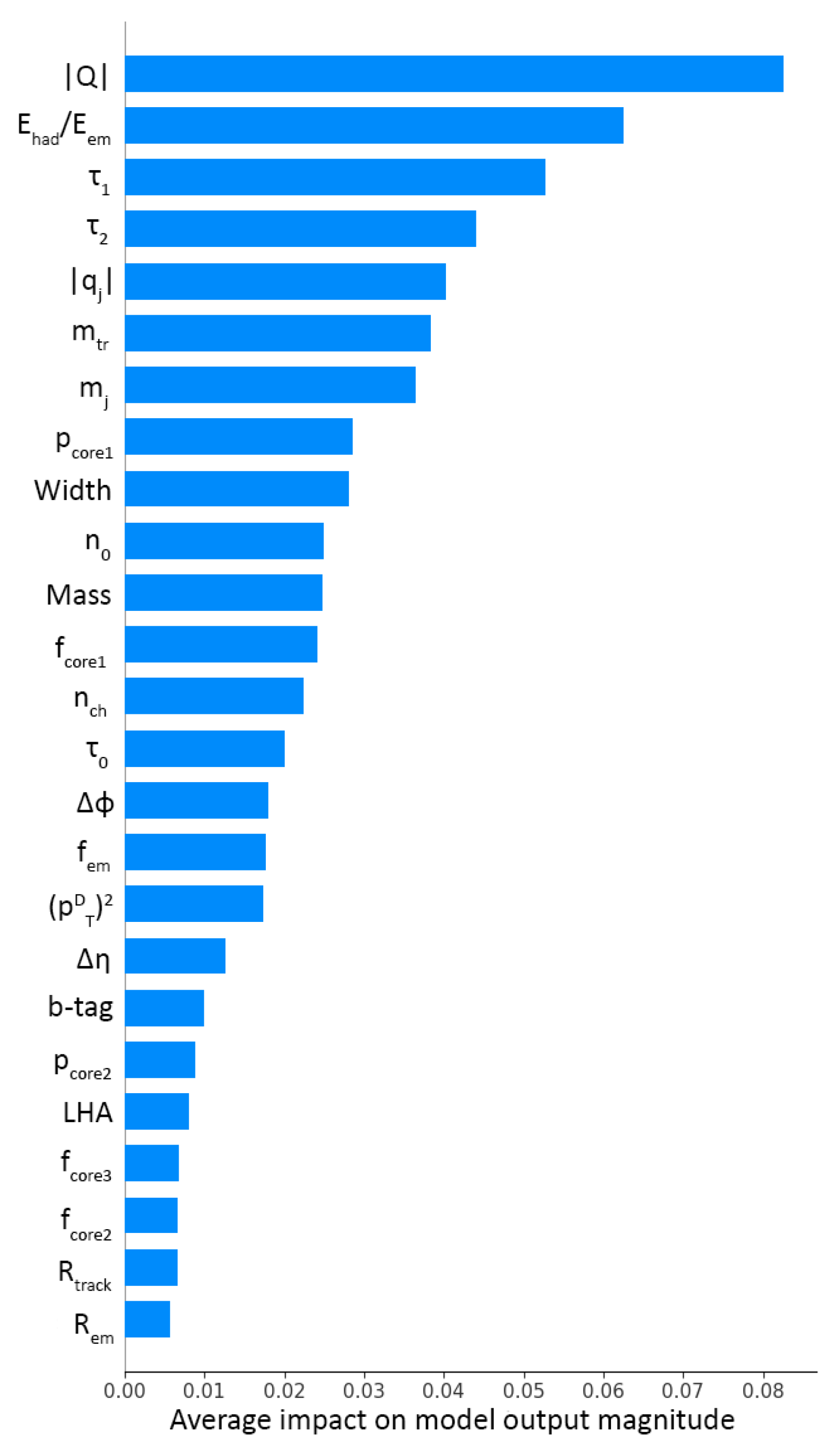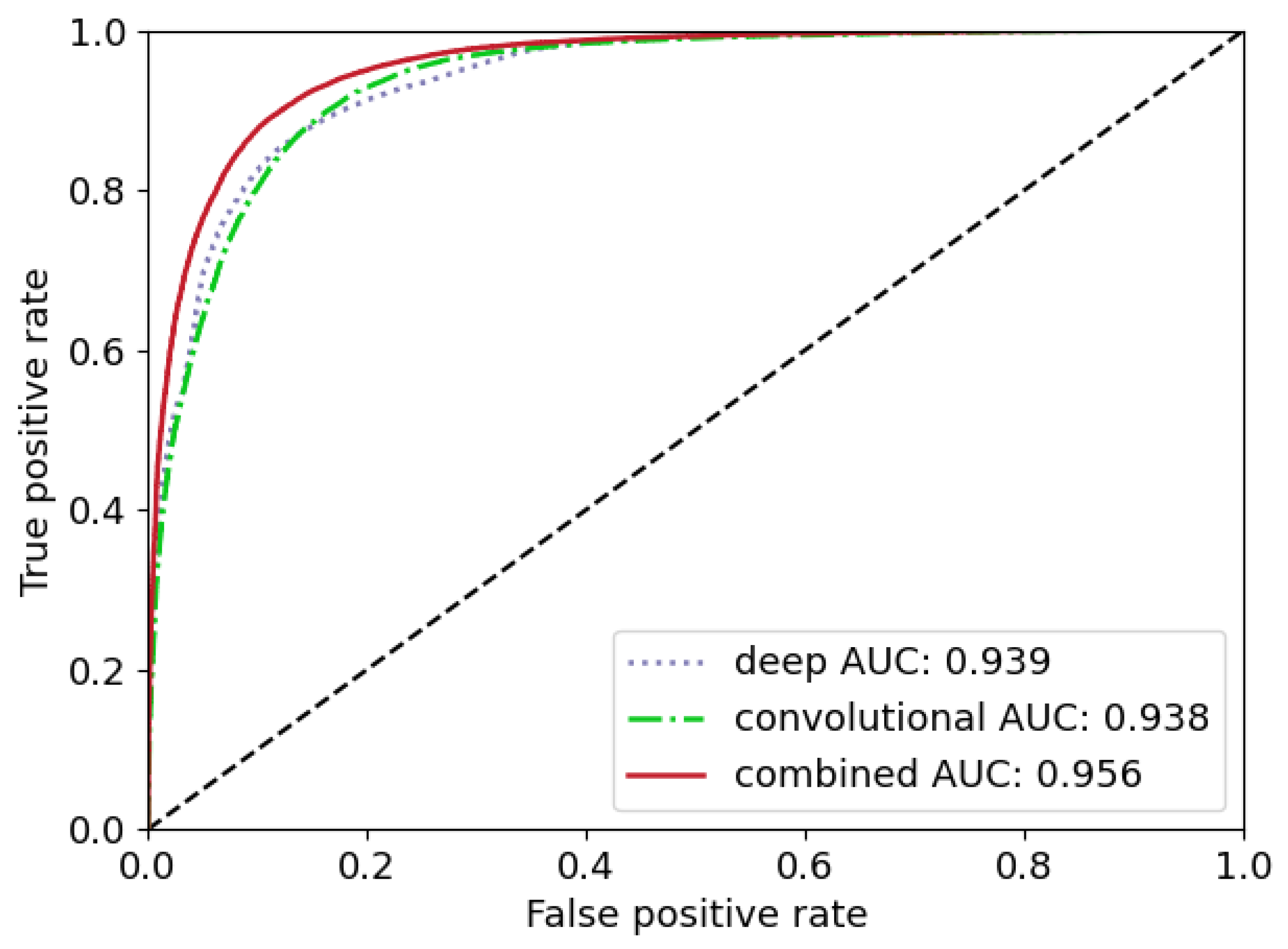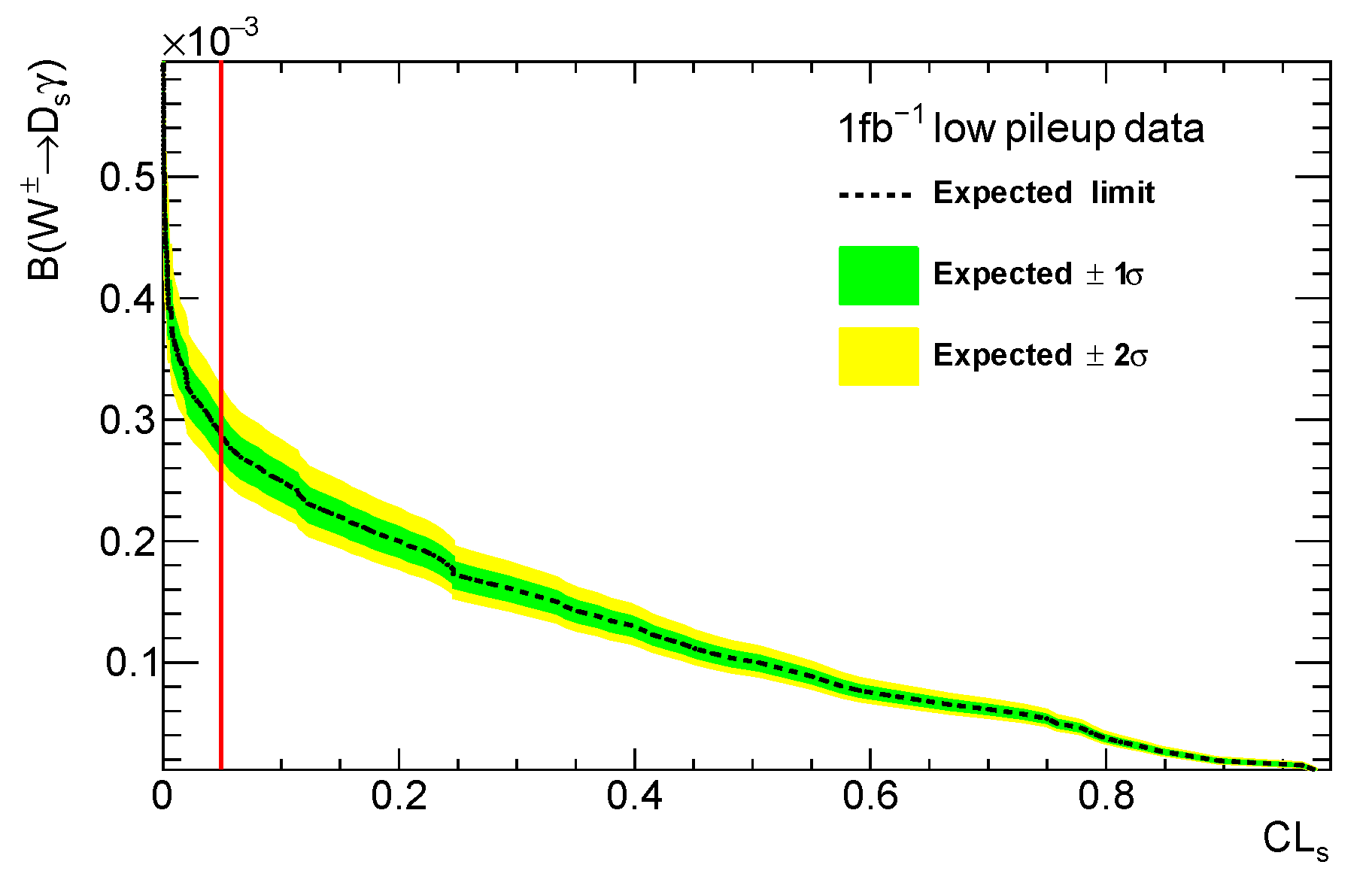Identifying D Mesons from Radiative W Decays at the Large Hadron Collider
Abstract
:1. Introduction
2. Materials and Methods
2.1. Simulated Samples
2.2. Identification Using Machine Learning Algorithm
2.2.1. Deep Neural Network
2.2.2. Convolutional Neural Network
2.2.3. Combined Network
3. Results
4. Discussion
5. Conclusions
Author Contributions
Funding
Data Availability Statement
Acknowledgments
Conflicts of Interest
References
- Grossman, Y.; König, M.; Neubert, M. Exclusive Radiative Decays of W and Z Bosons in QCD Factorization. J. High Energy Phys. 2015, 2015, 101. [Google Scholar] [CrossRef]
- Aaij, R.; Abdelmotteleb, A.S.W.; Beteta, C.A.; Abudinén, F.; Ackernley, T.; Adeva, B.; Adinolfi, M.; Adlarson, P.; Afsharnia, H.; Agapopoulou, C.; et al. Search for the rare decays W+→γ and Z→D0γ at LHCb. Chin. Phys. C 2023, 47, 093002. [Google Scholar] [CrossRef]
- Abe, F.; Akimoto, H.; Akopian, A.; Albrow, M.G.; Amadon, A.; Amendolia, S.R.; Amidei, D.; Antos, J.; Aota, S.; Apollinari, G.; et al. Search for the rare decay W±→γ in collisions at = 1.8 TeV. Phys. Rev. D 1998, 58, 091101. [Google Scholar] [CrossRef]
- de Groot, N.; Castells, S. Identifying hadronic charmonium decays in hadron colliders. SciPost Phys. Core 2020, 2, 8. [Google Scholar] [CrossRef]
- Alwall, J.; Demin, P.; de Visscher, S.; Frederix, R.; Herquet, M.; Maltoni, F.; Plehn, T.; Rainwater, D.L.; Stelzer, T. MadGraph/MadEvent v4: The New Web Generation. J. High Energy Phys. 2007, 2007, 28. [Google Scholar] [CrossRef]
- Alwall, J.; Frederix, R.; Frixione, S.; Hirschi, V.; Maltoni, F.; Mattelaer, O.; Shao, H.S.; Stelzer, T.; Torrielli, P.; Zaro, M. The automated computation of tree-level and next-to-leading order differential cross sections, and their matching to parton shower simulations. J. High Energy Phys. 2014, 2014, 79. [Google Scholar] [CrossRef]
- Ball, R.D.; Bertone, V.; Carrazza, S.; Debbio, L.D.; Forte, S.; Groth-Merrild, P.; Guffanti, A.; Hartl, N.P.; Kassabov, Z.; Latorre, J.I.; et al. Parton distributions from high-precision collider data. Eur. Phys. J. C 2017, 77, 663. [Google Scholar] [CrossRef]
- Sjostrand, T.; Mrenna, S.; Skands, P.Z. A Brief Introduction to PYTHIA 8.1. Comput. Phys. Commun. 2008, 178, 852–867. [Google Scholar] [CrossRef]
- Buckley, A. ATLAS Pythia 8 Tunes to 7 TeV Data; Technical Report ATL-PHYS-PUB-2014-021; CERN: Geneva, Switzerland, 2014. [Google Scholar]
- de Favereau, J.; Delaere, C.; Demin, P.; Giammanco, A.; Lemaître, V.; Mertens, A.; Selvaggi, M. DELPHES 3, A modular framework for fast simulation of a generic collider experiment. J. High Energy Phys. 2014, 2014, 57. [Google Scholar] [CrossRef]
- Cacciari, M.; Salam, G.P.; Soyez, G. The anti-kt jet clustering algorithm. J. High Energy Phys. 2008, 2008, 63. [Google Scholar] [CrossRef]
- Bakos, E. DsGammaAnalysis. 2022. Available online: https://github.com/ebakos/DsGammaAnalysis (accessed on 15 September 2023).
- Abadi, M.; Barham, P.; Chen, J.; Chen, Z.; Davis, A.; Dean, J.; Devin, M.; Ghemawat, S.; Irving, G.; Isard, M.; et al. TensorFlow: A system for large-scale machine learning. arXiv 2016, arXiv:1605.08695. [Google Scholar]
- Keras. 2015. Available online: https://github.com/fchollet/keras (accessed on 14 September 2023).
- Field, R.D.; Feynman, R.P. A Parametrization of the Properties of Quark Jets. Nucl. Phys. B 1978, 136, 1. [Google Scholar] [CrossRef]
- Larkoski, A.J.; Thaler, J.; Waalewijn, W.J. Gaining (Mutual) Information about Quark/Gluon Discrimination. J. High Energy Phys. 2014, 2014, 129. [Google Scholar] [CrossRef]
- Thaler, J.; Van Tilburg, K. Identifying Boosted Objects with N-subjettiness. J. High Energy Phys. 2011, 2011, 15. [Google Scholar] [CrossRef]
- Read, A.L. Presentation of search results: The CLs technique. J. Phys. G 2002, 28, 2693–2704. [Google Scholar] [CrossRef]
- Junk, T. Confidence level computation for combining searches with small statistics. Nucl. Instrum. Meth. A 1999, 434, 435–443. [Google Scholar] [CrossRef]
- Aaboud, M.; Aaboud, A.; Aad, G.; Abbott, B.; Abdinov, O.; Abeloos, B.; Abidi, S.H.; AbouZeid, O.S.; Abraham, N.L.; Abramowicz, H.; et al. Search for exclusive Higgs and Z boson decays to ϕγ and ργ with the ATLAS detector. J. High Energy Phys. 2018, 2018, 127. [Google Scholar] [CrossRef]







| Name | Description |
|---|---|
| width of the jet in | |
| width of the jet in | |
| invariant mass of all charged tracks in the jet | |
| invariant mass of all constituents of the jet | |
| charged particle multiplicity | |
| neutral particle multiplicity | |
| absolute value of the total charge | |
| jet charge ( weighted charge sum, ) | |
| b-tag | output of the b-tagging algorithm |
| average with respect to the jet axis weighted by electromagnetic energy | |
| weighted average for tracks | |
| fraction of EM energy over total neutral energy of the jet | |
| ratio of sum in a cone of 0.1 and the jet | |
| ratio of sum in a cone of 0.2 and the jet | |
| ratio of sum ET in a cone of 0.1 and the jet total ET | |
| ratio of sum ET in a cone of 0.2 and the jet total ET | |
| ratio of sum ET in a cone of 0.3 and the jet total ET | |
| LHA | Les Houches Angularity; |
| Width | |
| Mass | |
| ratio of the hadronic versus electromagnetic energy deposited in the calorimeter | |
| , , | N-Subjettiness |
| Parameter | DNN | CNN | Combined |
|---|---|---|---|
| Dense layer nodes | 35—20—12—1 | – | 33—20—14 |
| Dense layer activation | tanh—tanh—tanh—sigmoid | – | tanh—tanh—tanh |
| Convolutional layer nodes | – | 30—8—8 | 30—8—8 |
| Window size | – | [3 × 3], [3 × 3], [5 × 5] | [3 × 3], [3 × 3], [5 × 5] |
| Convolutional layer activation | – | tanh—tanh—tanh | tanh—tanh—tanh |
| Max pooling | – | After the 1st convolutional layer | |
| Dense layers after convolution | – | 10(relu)—1(sigmoid) | – |
| Combined layer nodes | – | – | 8—1 |
| Combined layer activation | – | – | relu—sigmoid |
| Loss function | binary cross-entropy | ||
| Optimiser | Adam | ||
| Training epochs | 40 | ||
| Batch size | 1024 | ||
| Network Type | Test Sample | Training Sample | AuC |
|---|---|---|---|
| DNN | vs. mixed | vs. mixed | 0.939 |
| CNN | vs. mixed | vs. mixed | 0.938 |
| Combined | vs mixed | vs mixed | 0.956 |
| vs. gluon | vs. mixed | 0.987 | |
| vs. quark | vs. mixed | 0.935 | |
| vs. gluon | vs. gluon | 0.991 | |
| vs. quark | vs. quark | 0.946 |
| Sample | Tagging Rate | |
|---|---|---|
| 79% | ||
| 9% | ||
| 1% | ||
| 62% | ||
| 3% | ||
| ( ) | 16% | |
| 12% | ||
| Jet with a truth | Jet without a truth | |
| 9% | 7% | |
| 1% | 3% | |
| Parameter | +Variation | −Variation |
|---|---|---|
| Var1: UE activity | −0.008 | 0.003 |
| Var2: jet shapes and substructure | −0.001 | 0.010 |
| Var3a: ISR/FSR gap | −0.002 | 0.007 |
| Var3b: ISR/FSR 3/2 jet ratio | −0.011 | 0.002 |
| Var3c: ISR | −0.007 | 0.006 |
Disclaimer/Publisher’s Note: The statements, opinions and data contained in all publications are solely those of the individual author(s) and contributor(s) and not of MDPI and/or the editor(s). MDPI and/or the editor(s) disclaim responsibility for any injury to people or property resulting from any ideas, methods, instructions or products referred to in the content. |
© 2023 by the authors. Licensee MDPI, Basel, Switzerland. This article is an open access article distributed under the terms and conditions of the Creative Commons Attribution (CC BY) license (https://creativecommons.org/licenses/by/4.0/).
Share and Cite
Bakos, E.; de Groot, N.; Vranjes, N. Identifying D Mesons from Radiative W Decays at the Large Hadron Collider. Symmetry 2023, 15, 1948. https://doi.org/10.3390/sym15101948
Bakos E, de Groot N, Vranjes N. Identifying D Mesons from Radiative W Decays at the Large Hadron Collider. Symmetry. 2023; 15(10):1948. https://doi.org/10.3390/sym15101948
Chicago/Turabian StyleBakos, Evelin, Nicolo de Groot, and Nenad Vranjes. 2023. "Identifying D Mesons from Radiative W Decays at the Large Hadron Collider" Symmetry 15, no. 10: 1948. https://doi.org/10.3390/sym15101948
APA StyleBakos, E., de Groot, N., & Vranjes, N. (2023). Identifying D Mesons from Radiative W Decays at the Large Hadron Collider. Symmetry, 15(10), 1948. https://doi.org/10.3390/sym15101948





